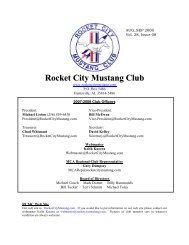2006 Ford Racing Performance Parts Catalog - Rocket City Mustang ...
2006 Ford Racing Performance Parts Catalog - Rocket City Mustang ...
2006 Ford Racing Performance Parts Catalog - Rocket City Mustang ...
You also want an ePaper? Increase the reach of your titles
YUMPU automatically turns print PDFs into web optimized ePapers that Google loves.
VALVE SPRINGS AND THINGS<br />
Valve springs are a critical part of valve train<br />
operation. They’re designed to exert a specific<br />
load at a specific installed height, thus spring<br />
selection and installation are important. A single<br />
spring is generally used for stock engines. Dual or<br />
triple springs are often necessary for performance<br />
applications to increase the load for a given<br />
installed height. If installed height isn’t sufficient<br />
to handle camshaft lobe lift, coil bind may occur.<br />
ROCKER ARMS AND STUDS<br />
429 BOSS, FE engines and some 4-cylinder<br />
rocker arms are shaft-mounted, while others<br />
are individually mounted (in several ways), as<br />
shown in the illustration. A non-adjustable stud<br />
is used in production engines with hydraulic<br />
cams. Mechanical camshafts require rocker<br />
arm adjustment to set valve lash (hydraulic cams<br />
with anti pump-up lifters also require adjustment).<br />
Installed spring height is the distance from<br />
the spring seat to the bottom of the valve retainer.<br />
Shims can be used under the spring to change<br />
spring height. If installed under stamped seat,<br />
shims and seat must have same outside diameter.<br />
Spring seats on most production engines consist<br />
of a boss machined in the head, on which the<br />
spring pilots. On stock performance engines<br />
(302 BOSS, 351C BOSS and HO, 429 CJ/SCJ<br />
and BOSS) the head is flat and the spring sits<br />
in stamped spring seat.<br />
<strong>Ford</strong> <strong>Racing</strong> offers spring seats for use with<br />
<strong>Ford</strong> <strong>Racing</strong> aluminum cylinder heads to prevent<br />
damage to the spring seat area.<br />
This is a conventional rocker arm with closetolerance<br />
slot in head to guide push rods and<br />
maintain rocker arm alignment. Can be used<br />
with mechanical or hydraulic camshafts.<br />
USAGE: All 289 high-performance and<br />
1963-661⁄2 standard 289<br />
Shown here is a “rail” rocker arm with “loose-fit”<br />
hole in cylinder head for push rods. The U-shaped<br />
rocker arms maintain alignment. Can only be used<br />
with hydraulic camshafts.<br />
USAGE: 19661⁄2-1968 standard 289<br />
1968-76 302 and 351W<br />
The illustration above is typical of<br />
351C-351M-400 canted valve engines<br />
(429-460 engines are similar). The rocker arm is<br />
mounted on a slotted pedestal, moves on a “sled”<br />
fulcrum, and is retained by a bolt. 351C BOSS<br />
engines use the 302 BOSS type valve train<br />
(also used on 429 CJ/SCJ), 1968-72 429/460<br />
with hydraulic camshafts use a screw-in positive<br />
stop stud. 1973 and later 429/460 have the<br />
351C-type slotted pedestal.<br />
Here is a modified valve train to convert<br />
rail rocker arm design for mechanical cam.<br />
Requires conventional rocker arms, guide plates,<br />
hardened pushrods (they rub on plates) and<br />
threaded adjustable rocker studs. Requires<br />
different guide plate than the one used with<br />
a similar 302 BOSS setup.<br />
USAGE: 289/302/351W with<br />
mechanical camshaft.<br />
A modified pedestal is used on 1978 and later<br />
302/351W engines. A stamped fulcrum guide<br />
is used with each pair of rocker arms.<br />
www.fordracingparts.com 225




